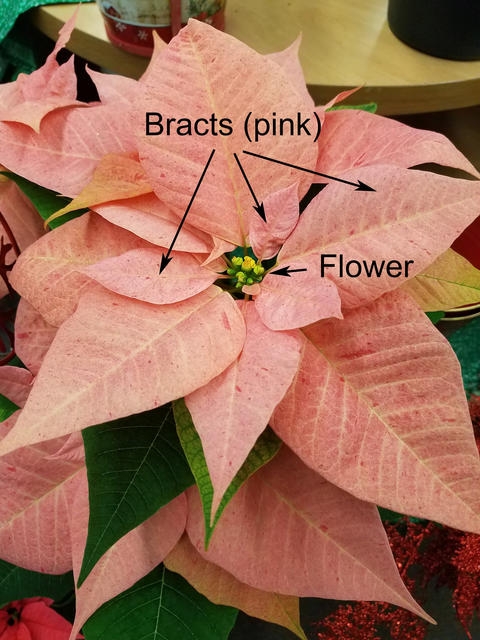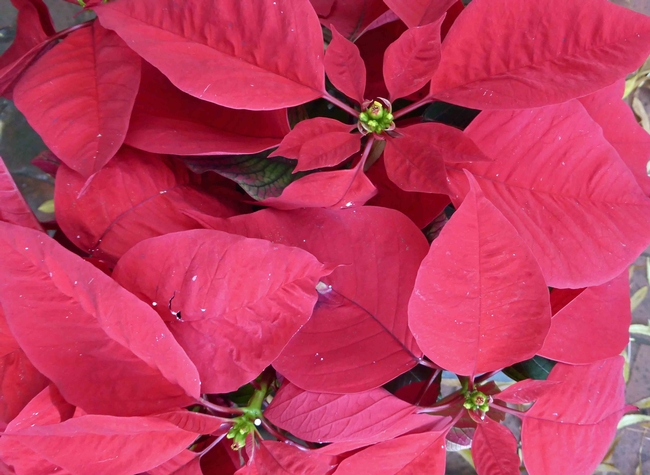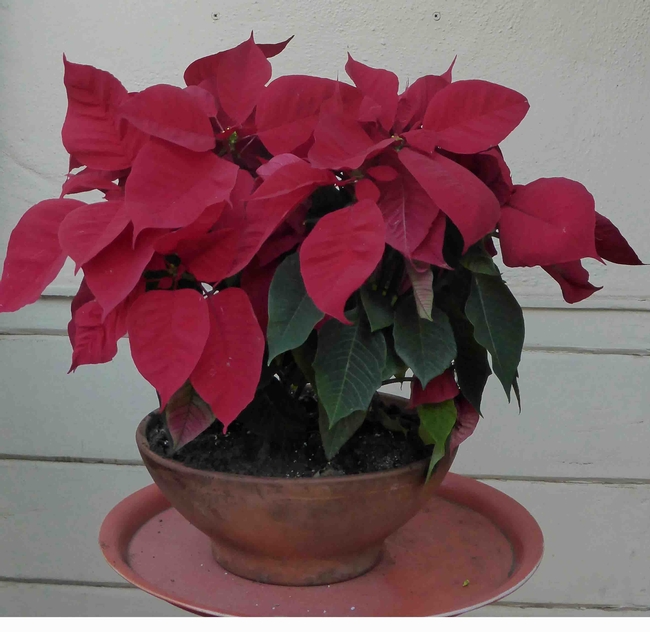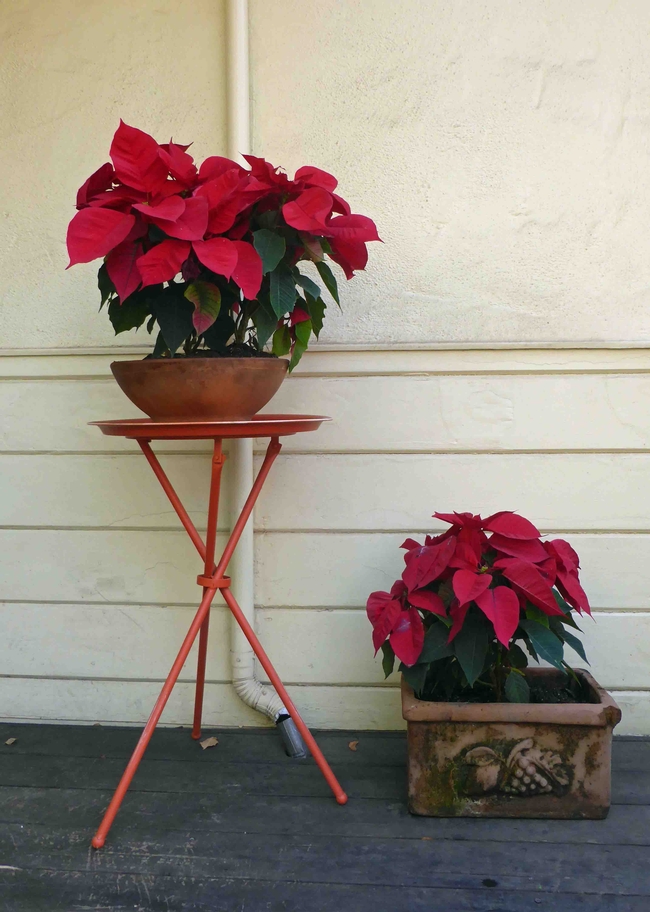The plant that graced the botanical gardens of the Aztec empire over 600 years ago, and the flower of Holy Night legends, is the poinsettia (poin seh tee uh), or flor de nochebuena in Spanish. Seen everywhere for sale during a short six weeks of the year, this plant has come to symbolize Christmas.

The poinsettia we know and love is Euphorbia pulcherrima. It grows wild all along the Pacific coast of southern Mexico and northern Guatemala, mostly on western-facing slopes in steep canyons of the tropical dry forest, where rainfall is limited by the long dry season each year. Wild populations of E. pulcherrima are also found further inland in the Mexican states of Guerrero and Oaxaca, where the climate is much hotter. In their native habitat, winter-flowering poinsettias grow large and bushy (up to 10 feet tall), with long stems and many smaller clusters of bright red or white leaves.
The first to cultivate the poinsettia were the Aztecs of 14th century Mexico, who prized the plant and called it cuetlaxochitl (coo eht la soch itl), “mortal flower that perishes and withers like all that is pure” (J.A. Burciaga, “La Cuetlaxochitl,” Drink Cultura: Chicanismo, 1993, p. 41). The Aztecs used the plant's red bracts to create dyes for textiles, and its milky sap (similar to latex) medicinally.
The first association of cuetlaxochitl with Christmas occurred in the 17th century when Spanish friars began using the plant in nativity processions. According to a legend from this period, a little girl had no gift to bring to the child Jesus (in the local nativity scene), so she picked a bouquet of weeds from the roadside. The child was ashamed to bring her gift of weeds into the church, but her cousin reminded her that “even the most humble gift, given in love, is acceptable in God's eyes” (Z. Sterkenberg, “The long, strange tale of the Poinsettia,” Holiday Plant Profile, Ambius, December 2, 2019). When she laid her gift before the child Jesus, the weeds miraculously turned into a beautiful bouquet of cuetlaxochitl or flor de nochebuena, (Christmas Eve flower), as it came to be called in Mexico.

The flor de nochebuena was at first called “Mexican flame flower” or “painted leaf” in the United States, and how exactly “poinsettia” became its permanent name is unknown. The plant next was sent to Scotland, and from there it reached German botanist Karl Willdenow in Berlin who named it Euphorbia pulcherrima in 1834 (Taylor et al).
Mexican growers of E. pulcherrima still believe that Poinsett deliberately prevented them from selling the plant internationally by obtaining a patent in the United States, although this document has never been found (Taylor et al). Poinsett was eventually recalled from his post in Mexico by President Andrew Jackson because of his diplomatic difficulties there, and the term “poinsettismo” is still used in Mexico to express officious and intrusive conduct (Burciaga, p. 44).

Clever marketing combined with hard work to produce superior plants enabled the Eckes to eventually control 90% of the poinsettia market (worth about $149 million annually by 2018) under the leadership of Paul Ecke, Sr., Albert's son. He began to market potted poinsettia plants in addition to cut flowers, and he licensed grafting technology to produce plants that were bushier and more attractive than competitors'. Ecke obtained patents and tested his varieties to make sure they could withstand neglect and rough handling, and he began marketing the poinsettia as the “Christmas flower,” providing his plants free of charge to the White House and to many magazines and television shows (including The Tonight Show). (Erica R. Hendry, “How America's Most Popular Potted Plant Captured Christmas,” Smithsonian Magazine, December 12, 2013).
In 1920 the discovery of photoperiodism in plants (seasonal changes in day length that induce flowering) led the floriculture industry to shorten the day length of poinsettias in greenhouses by covering them with black cloth to force flowering for the Christmas season.

According to Taylor et al., “other innovations in poinsettia production include plant pruning (pinching) to increase branching and the use of plant growth regulators (PGRs) to reduce stem elongation and final plant height. By increasing branching and controlling plant height, poinsettia producers can produce compact, high-quality plants that may also be packed, shipped, and sold on a cart in retail locations.”
The wildly successful marketing of poinsettias as Christmas flowers has, at the same time, limited their sales to about 6 weeks per year; however, there may be opportunities to move beyond the Christmas market. Examples include pink poinsettias for Valentine's Day or orange plants for Thanksgiving.
With reasonable care, today's poinsettia plants last well through the holidays and can even be induced to bloom again. When selecting a plant, look for one with green foliage down to the soil line, solid color in the bracts (pigmented leaves) and green- or red-tipped flowers in the center that look fresh and are pollen-free.
A potted poinsettia needs light, so placement near a sunny window is perfect. Room temperature should be 65 to 70 degrees and, if possible, slightly cooler at night, but not below 60 degrees. Avoid either hot or cold drafts, as these can cause premature leaf drop. Check the pot daily and water when the soil surface is dry; allow water to run through the drainage holes in the pot. “If a saucer is used, discard the water that collects in it. Do not leave the plant standing in water. Overly wet soil lacks sufficient air, which results in root injury. A wilted plant may drop its leaves prematurely, so try to keep it well watered. Plants exposed to high light and low humidity require more frequent watering.” (UCCE Center for Landscape and Urban Horticulture, Poinsettia Care, p. 1-2). Do not fertilize.
Although poinsettias are reputed to be poisonous when ingested by pets or small children, the truth is that they are only mildly toxic and irritating, not poisonous. According to Poison.org,
“In most cases, exposure to any parts of the poinsettia plant in children or pets has very little if any effect. If swallowed, it may cause mild irritation: nausea, vomiting, or diarrhea.” Touching it may cause a rash in sensitive individuals.
Aztec symbol of purity and sacrifice, Christian symbol of the nativity of Jesus, the poinsettia remains a beloved and beautiful part of our winter holidays. Whether the flor de nochebuena will move beyond Christmas and become a plant for other holidays, or for every day, remains to be seen.
UC Master Gardeners of Butte County are part of the University of California Cooperative Extension (UCCE) system. To learn more about us and our upcoming events, and for help with gardening in our area, visit our website. If you have a gardening question or problem, email the Hotline at mgbutte@ucanr.edu (preferred) or call (530) 538-7201.
